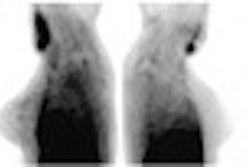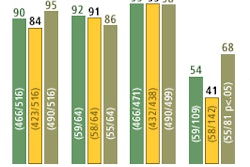Stress-gated SPECT imaging with a dobutamine-based radiopharmaceutical shows promise as a cardiac stress test, according to researchers from the Medical School of Ribeirao Preto in Brazil and the Hokkaido University Graduate School of Medicine in Japan.
Dr. Keiichiro Yoshinaga and colleagues from Hokkaido University Graduate School of Medicine in Sapporo looked at whether low-dose dobutamine stress-gated (DS) SPECT may provide additional value to stress-rest technetium-99m (99mTc) tetrofosmin SPECT for the detection of myocardial viability.
"The routine stress-rest perfusion scan often does not identify viable myocardium after myocardial infarction, so low-dose DS SPECT may provide additional information for identifying viable myocardium," said Yoshinaga in a presentation at the 2002 Society of Nuclear Medicine meeting in Los Angeles.
The researchers used standard stress-rest SPECT, DS SPECT, and FDG-PET imaging techniques in 23 patients with previous myocardial infarction. FDG uptake of 50% defined the gold standard of viability.
Pefusion SPECT imaging was performed using a one-day, 900-MBq protocol of 99mTc tetrofosmin (Myoview, Nihon Mediphysics, Hyougo, Japan). The scan required 20 minutes and was repeated three times; the exam took a total of 6 hours. This perfusion SPECT imaging protocol required only an additional 30 minutes compared to standard 1-day stress/rest protocol, Yoshinaga said. SPECT images were acquired using a dual-detector gamma camera (VXHR, Vertex, Philips Medical Systems/ADAC Laboratories, Milpitas, CA).
The combination of stress-rest SPECT and DS SPECT myocardium imaging achieved a sensitivity of 76%. The 76% sensitivity for the combination SPECT imaging technique was better than the stress-rest SPECT imaging sensitivity of 41.3%. The specificity of the combination SPECT imaging and stress-rest SPECT imaging alone are comparable at 86% and 89%, respectively.
"In the future, we will obtain the reversibility of regional wall motion after interventional therapy, and we will confirm the accuracy of this method," Yoshinaga said. These results will be published in an upcoming issue of the European Journal of Nuclear Medicine and Molecular Imaging.
In a second SNM talk, Dr. Marcus Simoes and colleagues from the Medical School of Ribeirao Preto, University of Sao Paulo researched the possibility of using low-dose dobutamine-gated (LDD) SPECT with thallium-201 for assessing early contractile reserve after acute myocardial infarction (AMI).
"We wanted to know if the gated SPECT 201-Tl is a safe and effective method comparable to the classical stress-echocardiography (SE) approach, regarding left ventricular function recovery at late follow-up," Simoes said.
The researchers imaged 36 consecutive stable post-AMI patients, who presented regional/global left ventricular dysfunction, within 8 days after AMI, first with stress echocardiography and then with the gated SPECT 201-Tl.
For the SPECT imaging, 3 millicuries of Tl-201 was used at stress and 1.5 millicuries at resting reinjection. Dobutamine was administered as continuous infusion at a rate equal to 10 micg/kg/min for 20 minutes. The total acquisition time for imaging was about 4 hours. The 4 hours includes stress-redistribution and 2 gated reinjection SPECT images, rest and low-dose dobutamine. The imaging time is about 20 minutes longer than the classical Tl stress-redistribution-reinjection SPECT protocol. The researchers used a dual-head DST camera (GE Medical Systems, Waukesha, WI).
"The new gated-SPECT imaging protocol presents advantages over the classical scintigraphic evaluation of regional uptake for prediction of myocardial viability in patients post myocardial infarction," Simoes concluded.
The contraction reserve (CR), defined as a 20% increase in mean wall motion scores for the gated-SPECT technique and SE are comparable. The accuracy, sensitivity, and specificity for gated SPECT were 73%, 91%, and 64%, respectively. For SE, the same measures yielded 74%, 70%, and 76%. According to Simoes, the next steps in research will be to study a large patient population cohort in long-term follow-up, and address the comparative prognostic importance of the findings.
By Laura RuthAuntMinnie.com contributing writer
August 19, 2002
Related Reading
PET identifies heart patients at risk despite lipid therapy, June 18, 2002
Stenting recommended as routine reperfusion strategy in AMI patients, March 30, 2002
Dobutamine stress echocardiography valuable after acute MI, December 7, 2001
Copyright © 2002 AuntMinnie.com



















